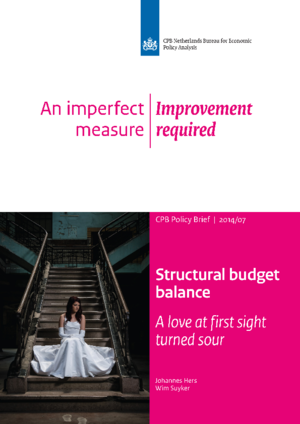Structural budget balance: a love at first sight turned sour
Structural budget balance indicator: improvements required
This is the conclusion by CPB researchers Johannes Hers and Wim Suyker, in the CPB Policy Brief 'Structural budget balance: a love at first sight turned sour', published today.
In order to assess the underlying fiscal policy effort, the structural budget balance indicator corrects the nominal budget balance for temporary factors and business cycle effects. The indicator depends heavily on the estimate of the output gap. Estimates of the output gap are, however, highly volatile. As a result, the structural budget balance indicator can send wrong signals. For example, it may signal no additional fiscal policy effort, while substantial additional measures have been taken.
The authors provide suggestions on how to improve the indicator. Moreover, they favour a more limited role of the indicator in the European Semester, arguing that it may be preferable to operationalize the fiscal policy measures in billions of euros. This would facilitate monitoring and assessment. Those adjustments are feasible within the current Stability and Growth Pact.
Read the accompanying press release.
The drawbacks of using structural budget balances as an indicator of a government’s fiscal policy effort and as a policy target include the following:
- The indicator is highly dependent on the volatile and often-biased estimate of the output gap. Estimates of the output gap (defined as the difference between actual and potential GDP) are very volatile. As a result, significant changes in the estimated structural balance for the same year can occur between different forecasting moments.
- The indicator can give the wrong signal. Substantial adjustments for a year can occur, even if fiscal policy does not change at all. The reverse is also possible, as significant fiscal policy changes can be offset by revisions of the output gap. Despite these policy changes, the structural balance then remains stable, suggesting a neutral fiscal policy effort. As will be shown in this Policy Brief, both cases have arisen for the Netherlands in the past years.
- Different estimates of the indicator lead to confusion. International institutions (European Commission, IMF, OECD) often provide diverging estimates of the size of the output gap, which results in marked differences between these institutions in both the level of the structural balance and the assessment of the fiscal policy effort.
The volatility of the structural balance is especially problematic because the indicator is used in the EU as a basis for the recommendations for a country. Volatile estimations could, for example, cause a government to be obliged to undertake significant additional fiscal consolidation in order to meet the structural balance requirement— only to be confronted with a structural balance that does not change at all, because of revisions in potential growth.
Given these drawbacks, a case can be made for improving the structural balance forecast by reducing revisions of potential output gap estimates (and thereby revisions of the structural budget balance). This could be done by shifting to stricter filters in the cyclical adjustment of actual series. It could also be done by shifting to an approach using underlying indicators to estimate structural unemployment and trend total factor productivity. As a commendable side-effect, this would bring European Commission estimates closer to the estimates of the OECD and the IMF, reducing confusion regarding the policy effort of member states.
Another way to improve forecasts would involve formulating recommendations for a country’s future policy in terms of ex ante fiscal consolidation measures. Monitoring and assessment could then focus on the actual additional policy effort vis-à-vis the required effort. Alternatively, some explicit provision could be made for interpretation of the outcomes of the structural balance.
